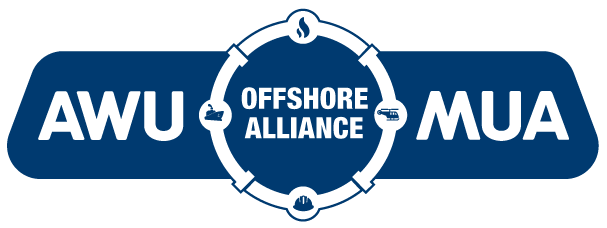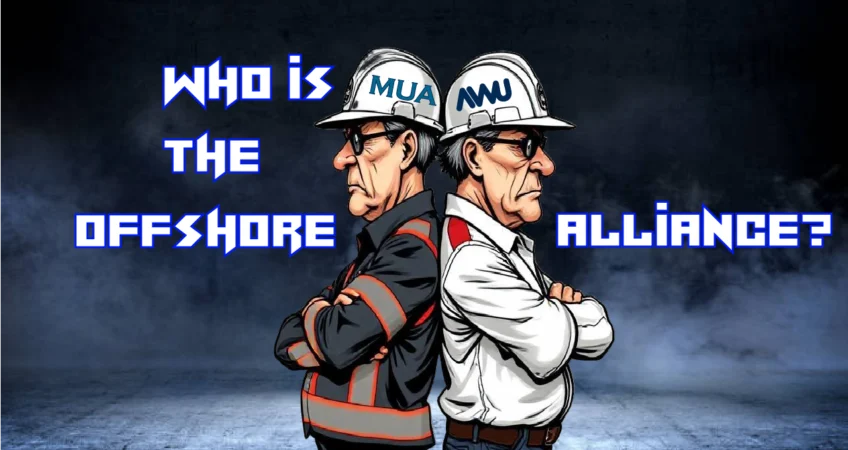The Offshore Alliance: A Trojan Horse for the AWU’s Old Habits
The Offshore Alliance, a collaboration between the Australian Workers’ Union (AWU) and the Maritime Union of Australia (MUA)—now a division of the CFMMEU—was formally established in 2018 under a Memorandum of Understanding. Ostensibly, it was created to bolster union power in the offshore oil and gas sector of Western Australia. But beneath the surface, many see it as a vehicle for the AWU to reassert itself using the credibility and militancy of the MUA, all while continuing a decades-long pattern of compromising workers’ interests.
In fact, a resolution passed by the AWU National Executive in February 2019 explicitly acknowledged that the Offshore Alliance had been operating since “the early 2000s.” This acknowledgement suggests that, even without a formal agreement in place, both unions had already been collaborating in various capacities to organise and represent offshore oil and gas workers for over a decade.

AWU’s Troubled Legacy
The AWU is one of the oldest unions in Australia, but it has not always stood on the right side of workers’ struggles. For decades, it has been widely criticised for its conciliatory and bureaucratic approach, often brokering agreements that favour employers over employees. The AWU’s primary tactic has been appeasement—signing off on deals that suppress industrial action and ensure peace in the workplace, frequently at the cost of real wage growth, job security, or improved conditions.
In many sectors where the AWU holds sway, workers have seen stagnating wages and reduced bargaining power. The union’s willingness to partner with corporations under the guise of “cooperation” has eroded its credibility with many in the broader union movement.
The Offshore Alliance: A Branding Exercise?
When the Offshore Alliance was launched, many workers saw the MUA’s involvement as a chance to revive real union militancy in the offshore oil and gas industry. The MUA, with its long history of fierce advocacy and member-led activism, brought a reputation the AWU lacked. But as details of the Alliance emerged, a different picture began to form.
Under the MOU, the AWU and CFMMEU share resources and organise jointly, but the membership applications are processed through the AWU’s West Australian Branch. All workers joining the Alliance are funnelled through this process, regardless of their actual trade or industrial alignment. While the Alliance is presented as a partnership, the paperwork and infrastructure tell a different story—control rests with the AWU.
In The AWUs Own Words
“The AWU is the principal union in the hydrocarbons industry with extensive membership in the sector.“
“In addition to significant membership in the sector, the AWU has a legitimate interest in the industry and occupations“
Follow the Money
A key point of concern is where members’ money goes. Alliance membership dues are set at $25 per week, or over $1,300 annually. According to evidence presented to the Fair Work Commission, these dues are split 50/50 between the AWU and the MUA, but the AWU administers the sign-up process, collects the fees, and processes membership data. This gives the AWU significant administrative control over member contributions—even for workers who think they’re primarily aligning with the MUA.
In effect, the AWU has leveraged the Offshore Alliance to:
- Expand its reach in an industry where its influence was waning;
- Collect dues from workers who may never have voluntarily joined the AWU on its own;
- Rehabilitate its image by co-branding with a more militant union.
Misleading Representation
Documents and promotional materials for the Alliance frequently blur the lines between the AWU and MUA’s representation rights. As noted by the Fair Work Commission in FWC Decision [2019] FWC 4733, many claims made by the Alliance—such as suggesting workers automatically become members of both unions—are legally inaccurate. In some cases, workers may not even be eligible to join both unions, yet are led to believe that their membership in the Alliance covers them comprehensively.
The Alliance, for all its coordinated campaign language, does not expand legal representation rights beyond the strict rules of each union’s constitutional coverage. This makes the Alliance not just potentially misleading, but structurally flawed in how it promises workplace representation.
AWU’s Betrayal: Backing CFMEU Administration and Selling Out Construction Workers
The Australian Workers’ Union (AWU) has long claimed to stand for “blue-collar” workers across Australia, but its actions in recent decades tell a very different story—particularly when it comes to its treatment of fellow unions and its complicity in moves to undermine militant unionism in the construction industry.
In one of the most telling examples of union disloyalty, the AWU openly supported efforts to place the CFMEU (Construction, Forestry, Maritime, Mining and Energy Union) into administration—a move widely seen as a political and legal assault on one of the most militant and effective unions in Australia’s history. The CFMEU, and its predecessors, have been responsible for some of the strongest enterprise agreements in the country, raising wages and improving safety conditions for construction workers in one of the nation’s most dangerous industries.
Rather than standing shoulder-to-shoulder with the CFMEU during times of state and employer crackdowns, the AWU has consistently taken the side of conciliation and appeasement—often publicly distancing itself from unions that engage in direct action, strikes, or worksite resistance.
This culminated in the AWU’s support for placing the CFMEU into administration, arguing that the union was out of control and needed to be “reformed.” But to construction workers, many of whom had experienced firsthand the gains won by the CFMEU through hard-nosed bargaining and jobsite mobilisation, this was a clear betrayal.
In essence, the AWU aligned itself with employer-friendly rhetoric that painted militant unionism as a problem rather than a solution. It sent a message: the AWU would rather see a powerful workers’ union dismantled than stand with it against government and corporate attacks.
The Irony of the Offshore Alliance
Today, the AWU positions itself as a partner of the CFMEU (through the Maritime Division) in the Offshore Alliance. It claims to be working “side by side” to fight for offshore oil and gas workers, using shared branding and joint campaigns. But to many in the construction sector, this partnership rings hollow.
How can the AWU now claim to collaborate with one arm of the CFMEU, while having previously supported moves to destroy another?
It appears that the AWU is willing to embrace militant unions only when it suits its strategic or financial interests—such as expanding its reach through the Offshore Alliance, where it controls the administration and collects half of all dues from members who believe they are joining both unions.
A Union That Bends with the Wind
The AWU’s conduct in relation to the CFMEU exposes its broader strategic posture: a union that bends to the political winds, even if it means betraying other unions—or worse, the workers it claims to represent.
In contrast to the CFMEU’s unapologetic and worker-led organising model, the AWU continues to operate as a top-down, compliance-oriented organisation, more concerned with maintaining political relevance than building power at the grassroots.
The AWU’s support for placing the CFMEU into administration was a clear betrayal of construction workers, and of the values of solidarity that underpin the union movement. By siding with state repression and employer narratives, the AWU has shown that it is willing to sell out even the most effective unions in the country when they don’t conform to its bureaucratic model.
Workers should not forget this history when evaluating the AWU’s current role in ventures like the Offshore Alliance. Because when push comes to shove, history suggests the AWU won’t be standing in the trenches—it’ll be standing with the bosses.
While the idea of union collaboration is commendable in principle, the Offshore Alliance raises red flags. It appears more as a rebranding effort for the AWU than a true partnership. The Alliance allows the AWU to benefit from the MUA’s reputation and reach, while retaining financial and administrative control and continuing its historically compromised approach to worker advocacy.
Workers in the offshore industry deserve strong, transparent, and militant representation. But if the Offshore Alliance is just the AWU in a new coat of paint, then it may be time to question whether it truly serves their interests—or merely extends the AWU’s decades-long pattern of selling them out.

